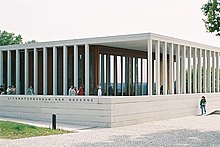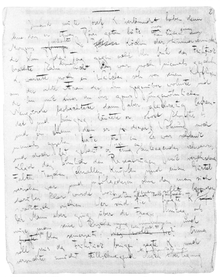Modern Literature Museum

The Modern Literature Museum (LiMo) , together with the Schiller National Museum, is part of the literary museums of the German Literature Archives . It is located on the Schillerhöhe in Marbach am Neckar . The focus of the exhibition is German-language literature from the 20th century to the present.
Heike Gfrereis has been the director of the museum department of the German Literature Archive in Marbach since 2001 . In 2017/18 she was represented by Ellen Strittmatter.
history
The museum was designed between 2002 and 2006 and built on the Marbacher Schillerhöhe. The building was handed over on January 9, 2006, and the official opening on June 6, 2006 in the presence of Federal President Horst Köhler .
Architecture of the Modern Literature Museum
The LiMo was planned by the British architecture firm David Chipperfield Architects and won the RIBA Stirling Prize 2007 from the Royal Institute of British Architects and was awarded the German Architecture Prize 2007. The project architect was Alexander Schwarz.
The building merges motifs from classic architecture, such as that of a periptero , with modern elements and materials such as wood, shell limestone, exposed concrete and stone.
Structure and exhibits of the LiMo
The museum shows exhibits from the holdings of the German Literature Archive from the early 20th century to the present on around 1000 m². Contrary to the orientation of many poets' houses, which make an author or an individual epoch the focus of their exhibitions, the Modern Literature Museum traces the development of German-language literature over the last 100 years in its permanent and accompanying temporary exhibitions.
2006 to 2015: nexus
When it opened in 2006, the permanent exhibition was divided into three rooms. In the fluxus room , prominent curators presented their personal contemporary literature; In the stilus room , visitors could rummage through modern literature with the interactive museum guide; and finally the nexus room . This formed the core of the exhibition; it showed the traces that people leave behind in and with literature. Around 1,300 exhibits were exhibited, including letters and certificates, ID cards, notebooks, photo albums, favorite books and memorabilia such as the slip boxes by Hans Blumenberg , Thomas Mann's baptismal dress or Hans-Georg Gadamer's scissors, manuscripts from Kafka's Proceß , Hesse's Steppenwolf , Döblin's Alexanderplatz , Kästner's Emil and the detectives . In addition to the permanent exhibition, there was also space for changing exhibitions.
Since 2015: The soul
On June 7, 2015, the new permanent exhibition of the Museum of Modern Literature opened with the name of the soul . Instead of around 1,300 exhibits in the nexus , only 280 can now be seen, but 220 of them that were previously not shown in the exhibition. Most of these are exhibits that the German Literature Archive Marbach has received through bequests and bequests over the past ten years . Few of the special features of the old collection, such as Kafka's Proceß , Döblin's Alexanderplatz or Kästner's Emil and the Detectives , are retained in the exhibition.
In addition to the new exhibits, the locations of the showcases and the arrangement have also been changed. They are now sorted according to years, so that the exhibits in the showcases give you an overview of the respective literary year. The old museum guides have been replaced by an app so that you can be guided through your soul using QR codes with your own smartphone or loanable tablet computers .
Exhibits (selection)
- Franz Kafka's The Trial (first and last page of the manuscript)
- Franz Kafkas The Village School Teacher (manuscript)
- Arthur Schnitzler's Lieutnant Gustl (manuscript)
- Hermann Hesse's The Steppenwolf (manuscript)
- Hermann Hesse's death mask
- Gottfried Benn's death mask
- Bertolt Brecht's death mask
- Friedrich Nietzsche's death mask
- Ernst Penzoldt's Die Powenzbande (manuscript rolls)
- Stefan Zweig's impatience of the heart (manuscripts)
- Helen Hessels translation of Vladimir Nabokov's Lolita (manuscript)
- Martin Heidegger's Being and Time (manuscript)
- Alfred Döblins Berlin Alexanderplatz (manuscript)
- Heinrich Mann's An Age is Visited (manuscript)
- Erich Kästner's Fabian (typescript)
- Jean Amérys On the Psychology of the German People (typescript)
- Thomas Bernhard's Der Untergeher (typescript)
- Thomas Bernhard's Extinction (typescript)
- Ingeborg Bachmann's Malina (manuscript)
- Hans Magnus Enzensberger's Landsberger poetry machine (machine and plans for the machine)
- Max Frischs Stiller (typescript)
- Martin Walser's marriages in Philippsburg (typescript)
- Bernward Vespers The Journey (Manuscript)
- Michael Ende's The Neverending Story ( typescript )
- Peter Handke's public abuse (typescript)
- Peter Handke's Slow Homecoming (Manuscript)
- Christoph Ransmayr's The Last World (typescript)
- Bernhard Schlinks The Reader (Manuscript)
Temporary exhibitions (selection)
Every year, around 2 to 4 new temporary exhibitions open in the Modern Literature Museum, which can be seen over a period of several months. In the past this included:
- 2009: Schiller autopsy. A literary investigation . It commemorated Friedrich Schiller's 250th birthday .
- 2010: The first exhibition in 2010, titled Marginal Drawings, featured drawings by various authors on their manuscripts.
- 2010: German spirit. An american dream ; Exhibition catalog by Ernst Osterkamp and David E. Wellberry: Marbacher Magazin 132, 2010 ISBN 978-3-937384-68-9
- 2011: fate. 7 times 7 inevitable things : letters, books and objects on the subject of the power of fate
- 2011: Letters to Ottla. From Franz Kafka and others
- 2011/12: I love you! : Exhibition on the love expressions of numerous writers and thinkers from the 19th to the 21st century.
- 2012: 1912. A year in the archive : Reconstruction of a year based on DLA manuscript sources.
- 2012: Kassiber. Prohibited Writing : An exhibition on clandestine writing in times of political repression.
- 2013/14: August 1914. Literature and War : Using diary entries, notes, manuscripts and photographs, the exhibition shed light on the beginning of the First World War . The catalog for the exhibition also contained previously unpublished records by Marie-Luise Kaschnitz , Georg Picht and Friedrich Gundolf .
- 2013/14: The whole process : The temporary exhibition showed Franz Kafka's "Process" manuscript sheet by sheet for the first time, thus offering an insight into the Prague poet's working methods.
- 2014/15: The value of the original
- 2015/16: The book in motion
- 2016: within the exhibition series fluxus 34: »Errata. Second hand errors. A conversation in x key words with Hanns Zischler «
- 2016: within the exhibition series fluxus 35: Sibylle Lewitscharoff / »In the labyrinth of circles. From a Dante Roman workshop. "
- 2017: Rilke and Russia
- 2018: The Invention of Paris : Imaginary Paris from Heinrich Heine to Peter Handke
- 2019/20: Dostoyevsky and Schiller (in collaboration with the State Literary Museum of the Russian Federation)
Goals of the LiMo
The purpose of the LiMo is, according to his own statement: “That archives are the memory of our culture, that they record the traces of life, everyday coincidences and great history as well as the work on artistically structured text, these are truisms that change annually Leitmotifs should be put to the test. "
With its permanent exhibition, the museum aims "at nothing less than the soul of German literature", which is to be unfolded on the basis of originals. Key questions for this mediation work are named as follows: "What is literature? What can it do? What remains of it when you look for it in the archive from 1899 to 2001?" Since the Modern Literature Museum draws from the holdings of the German Literature Archive in Marbach , the LiMo also provides an insight into the collection activities of a literature archive .
Secondary literature
- Heike Gfrereis and Ulrich Raulff (eds.): The soul. The permanent exhibition in the Modern Literature Museum , book accompanying the new permanent exhibition in the Modern Literature Museum, Marbach am Neckar (Marbach Catalog 68), Marbach am Neckar 2015, 432 pages.
- German Literature Archive Marbach (ed.): Thoughts and showpieces. The Modern Literature Museum , catalog accompanying the permanent exhibition (Marbach Catalog 60), Marbach am Neckar 2006 (2nd edition: 2008), 260 pages.
- Sonja Lehmann: Alienated, revived. Notes on the aesthetics and display methods in the permanent exhibition of the Museum of Modern Literature. In: Textpraxis. Digital Journal for Philology 2/2011. Digitized
Web links
- Website of the German Literature Archive Marbach
- Channel of the Museum of Modern Literature on YouTube
- Architecture of the LiMo
- The new museum app for Android
Individual evidence
- ↑ Article of the world about the new exhibition.
- ^ Article by SWR on the new exhibition.
- ↑ Article of the world about the new exhibition.
- ↑ a b https://www.dla-marbach.de/museen/literaturmuseum-der-moderne/
Coordinates: 48 ° 56 ′ 6.6 " N , 9 ° 15 ′ 19.2" E




